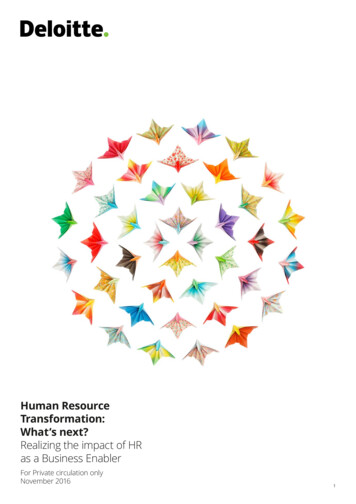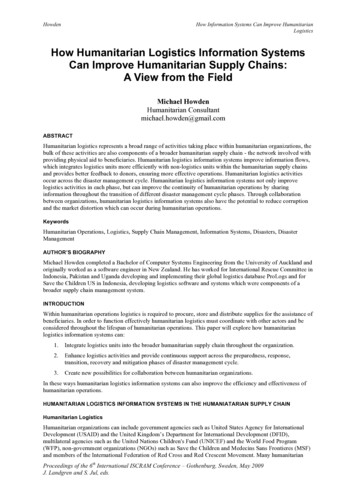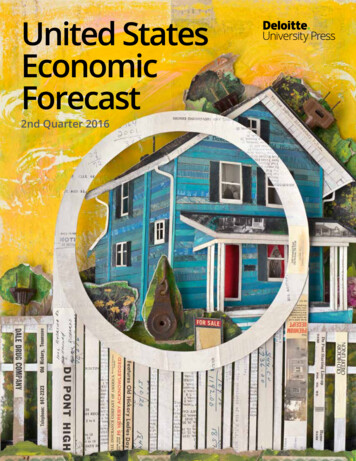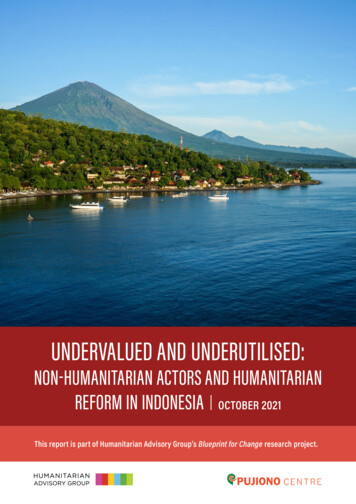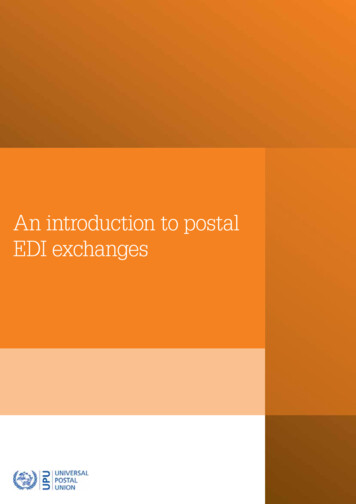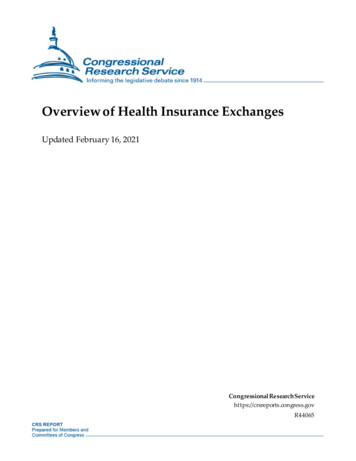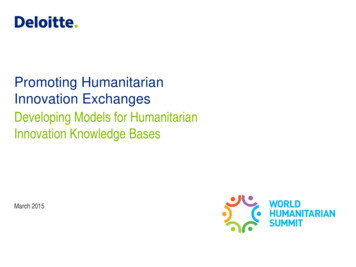
Transcription
Promoting HumanitarianInnovation ExchangesDeveloping Models for HumanitarianInnovation Knowledge BasesMarch 2015
AcknowledgmentsDeloitte’s Social Impact practice would like to acknowledge the contributions of the working group under the“Transformation through Innovation” theme of the World Humanitarian Summit secretariat, who provided guidanceand review of the methodology and ultimate findings from this report. Special thanks to Joanna MacRae, KimScriven, Mahsa Jafari, and Lesley Bourns as well as the over 30 interviewees who provided their time,expertise, and candid thoughts.A special thanks to Stephanie Erwin Hunt, contributing member of the working group, who spearheaded this effort.The project was also supported by the Deloitte Humanitarian Innovation Program, which seeks to strategicallysupport humanitarian organization by delivering the skills and expertise of Deloitte member firm professionals on apro bono basis.This presentation has been developed and published with support from the organizations and individuals listedabove. The findings, conclusions and recommendations contained within these pages are those of the authors anddo not necessarily reflect the views, positions or policies of any of these organizations.1
Table of Contents Executive Summary3 Research Methodology and Core Findings5 Model 1: Research Navigator15 Model 2: Solution Mobilizer24 Model 3: Experience-Driven Validator33 Comparison of Alternative Models42 Constructing a Model47 Appendix51– Key Components of an IKB52– Understanding the Current Humanitarian System59– Case Study Overviews71– Micro-Case Studies902
Executive Summary (1/2)Motivation andContext Humanitarian crises occur with distressing regularity, creating needs for assistance that are growing in scopeand scale To effectively address these challenges given resource constraints, humanitarian actors increasingly recognizethe need for innovation in the sector Key bottlenecks to innovation in the humanitarian space are:– A lack of consensus on “what works” and an inability to compare new solutions and practices– Insufficient processes, infrastructure, tools, and talent to identify, support, validate, and disseminateinnovationsOpportunity To address these innovation bottlenecks, the humanitarian sector should take a holistic view of the componentsthat foster or inhibit the identification and spread of effective innovation and examine their interactions anddependencies to design appropriate solutions An innovation knowledge base (IKB) – the ecosystem of players, processes, technologies that enable validcomparisons about what works and create incentives and governance mechanisms to act on and adoptthat innovative knowledge – can be designed to take this comprehensive view to facilitate innovation By applying this holistic lens to the humanitarian space and exploring the IKBs in analogous sectors, wecan create IKB models that are customized to the humanitarian context and provide a range of potentialsolutions to stimulate and sustain innovation in the sectorCore Objectives Our objectives are to:1. Articulate distinct IKB models, drawing from analogous sectors, to spur innovation in the humanitariansector2. Enable the field to have an extended conversation about what IKB is most appropriate and to design ahybrid IKB best suited to the unique needs of the sector3
Executive Summary (2/2)ResearchMethodology We examined case studies in five analogous sectors (military, healthcare, construction, technology, andacademia/engineering) to identify core success factors of IKBs that could be applicable to the humanitariansector Findings from our case studies led to three generic IKB models – Research-Oriented, Solution-Driven, andExperiential – that were found to successfully stimulate innovation knowledge sharing and adoption We explored the unique contextual characteristics and challenges faced by the humanitarian sector to identifycore barriers to innovation in the humanitarian system to best tailor these generic models to thehumanitarian context Three tailored IKB models – Research Navigator, Solution Mobilizer, and Experience-Based Validator –were formed customized to the humanitarian context Finally, we drew inferences from each model to identify specific tradeoffs that could be used as building blocksto design a hybrid IKBResearch Navigator: A central research authority that interfaces directly with affected populations tocollect robust data on their needs and the impact of interventions, and uses this evidence base to informfunding priorities and drive progressTailored IKBModels for theHumanitarianSectorSolution Mobilizer: Builds a portfolio of proven innovations and lessons learned by, first, poolingfunding to create dedicated financing for innovation and partnerships and, second, using a stage-gatedprocess to synthesize lessons and evaluate effective ideas for additional funding at each stageExperience-Based Validator: An external knowledge network that focuses on collaborations with nontraditional humanitarian actors to translate and develop innovations from other sectors and leveragespractitioner experience to evaluate and endorse successful, high-impact innovations4
Research Methodology and Core Findings
Our ApproachTo articulate IKB models for the humanitarian sector, we analyzed analogous sectors to inform generic models,conducted interviews and research to understand the humanitarian context, and designed customized modelsContext & Supporting Evidence1Proposed Models3Drawing Inferencesfrom Analogous SectorsModel development began withan exploration of analogoussectors to identify core successfactors that could be applicableto the humanitarian sector2Exploring theHumanitarian ContextGeneric models were then evaluatedagainst the unique contextualcharacteristics and innovation barriersfaced by the humanitarian sectorthrough interviews and research4Leading toGeneric ModelsDeveloping TailoredHumanitarian IKB ModelsAfter examining these core barriers,the generic models were tailored tomeet those specific challenges andalign to relational dynamics in thehumanitarian sectorFindings from our case studiessuggested three potential genericmodels that could be used tostimulate innovation knowledgesharing and adoption6
Case Studies to Inform Innovation Knowledge Base ModelsTo get a sense of the range of IKB options from which the humanitarian sector might draw, we conducted researchon five analogous sectorsSectorSector DefinitionRelevance toHumanitarianStrength ofInnovationsStrength of InnovationEcosystemMilitary andDefenseThose charged with defending states and their citizens and supportingthe prosecution of war. This includes armed forces, civilian oversightagencies, and companies/research institutions developing and deliveringmilitary solutions and technology.HighHighMediumHighLowLowThe stakeholders involved in the delivery of medical services and thedevelopment and regulation of new medical procedures and solutions(other than pharmaceuticals). Key players include health care providers,medical schools, regulatory agencies, and professional associations.HighHighHighAcademia –The stakeholders involved in academic research and teaching ofEngineeringengineering sciences, including universities and their staff and students,government bodies and funders, and industry end users.LowHighMediumTechnology – The organizations and individuals involved in the technology sectorSoftwarefocused on Internet-based and software solutions including games andmobile applications—narrowed to organizations that offer technology asa service rather than using technology to enable other functions.LowHighHighConstruction The organizations and individuals involved in the planning anddevelopment of new buildings and other types of infrastructure. For ourpurposes, this includes architects, engineers, contractors, constructioncompanies, and suppliers.Healthcare7
Sector SnapshotsEach of the analogous sectors examined takes a slightly different approach to an IKB based on its specificchallenges and contextual characteristicsMilitary and DefenseThe military IKB is characterized by itsfocus on collecting and integratinglessons and experience frompractitioners. Relies on a strong centralizedgoverning bodies process to sourceand disseminate innovations Utilizes rigorous training institutions,systems, and doctrine to disseminateinnovations and new practicesConstructionHealthcareThe construction IKB is characterizedby a fragmented network of smallplayers who individually collect anddisseminate new insights within theirown organizations. Demonstrates success in spreadingstandards across the industry via theISO’s construction guidelines Professional associations yield mixedresultsAcademia – EngineeringThe healthcare IKB prioritizes researchand evidence-based decision making. A strong central coordinating body – theWorld Health Organization – convenesnational and subnational actors to alignaround common goals, fund high-prioritychallenges, and share knowledge Benefits from strong publicity and highlevels of funding for R&D and innovationTechnology – SoftwareThe engineering academia IKB is orientedaround researchers and publications toshare innovations and knowledge. Government funding and academicindustry partnerships play a key role indriving innovation and research Peer-review and publication processeshelp promote sharing of knowledgethroughout the sectorThe Internet and software-basedtechnology sector is characterized by itslack of a formal IKB and focus onscaling specific solutions. Near-instant market feedback loopshelp drive innovation in the sector Angel investors and venture capital(VC) firms provide funding and advicethroughout the innovation lifecycle8
Three Generic IKB ModelsFrom this analogous sector research, three basic types of IKBs emerged that can stimulate the exchange ofinnovation knowledge within a given sectorResearch-Oriented ModelHow it WorksIncentivesGovernanceAnalogousSector ReferenceSolution-Driven ModelExperiential Model Scientists/academics conduct researchon various topics of interest Findings are published, critiqued, andleveraged, and knowledge accumulatesin a body of literature Peer review and agreed uponstandards of evidence andmethodologies mediate what gets inand what is kept out Entrepreneurs develop ideas/solutionsand form enterprises around them Funders seeking a ROI chase goodideas/solutions and invest in them Knowledge that something works isrevealed through real-world success(e.g., revenues), and entrepreneursadvertise this to gain more funding Practitioners come to know whatworks through long experience They share tradecraft and lessonslearned through a structuredprocess in after-action reports Knowledge is codified, stored in astructured database, and spreadthrough training, doctrine, andstrategy Culture/reputational incentives ascareer advancement comes frompublication, and only new knowledge(i.e., innovative ideas) get published Funders can use financial incentives todrive research Organizations and practitioners aredriven by financial and reputationalincentives to submit ideas to funders Funders get a return on successfulinnovations and use the knowledge toevaluate future ideas Practitioners are driven to codifyknowledge using financial (fundersrequire After Action Reports) andreputational (recognition as anexpert) incentives Practitioners are incentivized andenabled to attend training events The IKB exists and grows organically It is not really centrally owned andmanaged but accumulates in an opensource fashion IKBs are held closely and managed byfunders, and shared openly acrossinformal communities by entrepreneurs IKBs are held closely and managedby centralized authorities Dedicated personnel collect, build,and sustain the IKBAcademia EngineeringHealthcareTechnologyMilitary and DefenseNote: The construction sector had elements of both the experiential and research-oriented IKB models, but was much more diffused and not easily categorized in a single model archetype.9
The Humanitarian SystemThe generic models frame the “solution set” for IKBs that could be applicable to the humanitarian sector, but musttake into account the complex set of actors and challenges that exist in the humanitarian systemShort-term orientationCoordinating BodiesHost GovernmentsLack of formal methods foradopting innovationsInsufficient resources forinnovationFundersImplementersAffected PopulationResearch & AssessmentInsufficient evidence baseLack of standards & metricsSource: Interview Findings (January – February 2015); Rush, et al. “The Eight Rs: components of the humanitarian innovation ecosystem“ (June 2014)10Lack of customer insightand coordination
Core Barriers to Innovation for the Humanitarian SectorWe validated these core challenges through 30 interviews with leaders in the humanitarian sector and innovationmanagement and distilled them into a set of five core innovation barriers that inform our tailored modelsBarrierShort-TermImpactOrientationDrivers Budgets are short-term (projector annual) and organizationsevaluate and incentivize theirpeople on similar timelinesLack ofStandards& MetricsLack ofAlignmenton MajorIssuesIllustrative Interview Finding Donors fund specific projects rather thantaking a portfolio approach to innovation Fear of failure and a reluctance to rapidlydevelop and test ideas“A key barrier preventing effective knowledgesharing in the sector is the lack of investmentin its infrastructure—you need to have a spaceto convene and broker ideas and connections.”Donors are driven to fund quick, Lack of funding for organizationalvisible wins or projects in theinnovation capacitydirect provision of aid Lack of talent and organizationalBias from funders towardssupport for innovation processesfunding large agencies“The system is focused on delivery and gettingthings to people – there’s not a huge amount ofspace for innovation. The way it’s financeddoesn’t help – donors want things that arevisible, that make them look good.” Weak mechanisms to share best Evidence for new practices has to bepractices and belief that issuesrobust and communicated well to beare context-dependentadopted Reluctance to try unproven Perverse incentives push actors awaymethods because lives are at riskfrom collaboration and partnerships“In the humanitarian context, competition leadsto inefficiency because actors don't want tolend credibility to competitors by adopting theirprocess or methodology or innovation” Lack ofInnovationResources HighBurden ofProof forAdoptionImplication for Innovation High-degree of fragmentationand diverse stakeholders No governing authority todefine standards No standards for data collection orimpact measurement Difficult to identify/communicatechallenges and compare solutions todetermine what works“In terms of innovation – how do you definewhat's in vs. what’s out? Its not just about whatworks for each innovation, its about whatbecomes the new minimum standard.” No agreement on the “right”set of issues to address Diverse sub-sectors involved Lack of resources for later stages ofthe innovation process No prioritization of systemic issuesacross clustersThe knowledge base underpinning the sectoris very broad – water engineers, nutritionists,logisticians, etc. The clusters all feel that theirproblems are unique and the most important.”Source: Interview Findings (January-February 2015); Rush, et al. “The Eight Rs:components of the humanitarian innovation ecosystem“ (June 2014)11
Current Efforts to Address Innovation BarriersActors in the space have made some attempts to address the core barriers, but current efforts do not effectivelyaddress the core barriers in a holistic manner to enable knowledge sharing, innovation, and adoptionCore BarrierExample of Actors Addressing BarrierEffectiveness to DateShort-TermImpactOrientationUSAID’s DIV program invests comparativelysmall amounts in a portfolio of relativelyunproven concepts and continues to supportonly those that prove they work through astage-gated funding processHighly attractive model for sourcing & scalinginnovations; however, the venture fund’sfocus is significantly broader than just thehumanitarian fieldLack of FundingResources forInnovationHumanitarian Innovation Fund (HIF) offersgrants for problem identification, development,and scaling of innovative solutionsWidely considered a leader in the field, butthe fund is relatively small and lacks thescale to be transformativeHigh Burden ofProof forAdoptionUNHCR and UNICEF have developedinnovation labs and initiatives that are activelyexperimenting and piloting with new ideas onthe groundAble to test and develop innovationsapplicable specifically to refugees/children,but limited ability to stimulate broaderadoption by other actorsLack ofStandards &MetricsMultiple organizations have made efforts toissue certifications for individual practitionersand devised a set of benchmarks for qualityand accountabilityHighly respected in the sector; however,organizations have overlapping mandatesand competing standardsLack ofAlignment onMajor IssuesAcademic programs such as the HarvardHumanitarian Initiative and the HumanitarianFutures Programme (King’s College) useevidence and data to determine issues to solvein the sectorAble to identify key problems within aspecific situation or context, but unable toholistically identify problems across theentire sector. Some programs are highlyspecialized and focus on specific niches(e.g., women in conflict)12
Tailored Humanitarian IKB ModelsOur case study insights coupled with an understanding of the unique challenges and current efforts in thehumanitarian sector led us to three potential models for IKBs to promote knowledge sharing and adoptionResearch NavigatorSolution MobilizerExperience-Driven ValidatorA central research authority thatinterfaces directly with affectedpopulations to collect robust data ontheir needs and the impact ofinterventions as well as defines thestandards and metrics for thecollection of this data. The IKB usesthis evidence base to influencedonors and inform fundingpriorities, thereby driving progressBuilds a portfolio of proveninnovations and lessons learnedby, first, pooling funding frommultiple donors and creatingdedicated financing for collaborativepartnerships and innovations and,second, using a stage-gated processto synthesize lessons and evaluateeffective ideas for additional fundingat each stageAn externally hosted,independent knowledge networkthat focuses on collaborations withnon-traditional humanitarianactors to translate and developinnovations from other sectors andleverages practitioner experienceto evaluate them in the field toultimately endorse successful, highimpact innovationsAnalogous Sector: Healthcare,ConstructionAnalogous Sector: Technology,HealthcareAnalogous Sector: Military,Academia13
Tailored Humanitarian IKB Models DetailsThese three models have different knowledge types, involve different players that incentivize change, and havediffering governing structures that distinguish each model from the othersResearch NavigatorSolution MobilizerExperience-Driven ValidatorHow itWorks Central body defines standards andmaintains repository of data on userneeds as programmatic assessments Research and assessmentorganizations conduct research on userneeds and program M&E Funders can access data and findingsto determine key issues and bestpractices to inform priorities Practitioners and others (e.g., socialenterprises) develop solutions Coalition of donors and private sectoractors establish pooled fund and stagegated process to fund successful ideas Key lessons learned about whichsolutions work and which don’t fromthe fund’s portfolio are captured,synthesized, and shared Independent researchers source andadapt innovations from other fields tohumanitarian context A network of credible practitionersevaluate adapted solutions in the field IKB endorses best practice solutions;participating actors have access tomethods, lessons learned, andexpertise networksIncentives Implementers encouraged to innovate,comply with standards, and adopt bestpractices in order to be morecompetitively positioned for donorfunding Donors yield reputational gains indemonstrating greater impact per dollarspent Practitioners driven by financial andreputational incentives to developsolutions Donors realize reduced opportunitycost and risk of investing in innovation Private sector partners receive R&Dexperience and reputational incentives Recognition (reputational incentive)drives practitioners to participate Relief agencies allow talent to secondto IKB to access shared expertise andpractitioner networks as well as greateraccess to donors and funding Private sector actors receive exposureto reverse innovation opportunities Governed by central M&E body Funded by public & private donors Additional funder convener can driveconsensus on priorities Coalition of donors fund mobilizer;grant selection is donor-blind Diverse team of leaders from VC,impact investing, & humanitarian fields Private sector partners and researchinstitute fund centralized, externalresearch hub Led by practitioners and researchersAnalogous Sector: Healthcare,ConstructionInternal: ALNAPAnalogous Sector: Technology,HealthcareInternal: HIF and START NetworkAnalogous Sector: Military, AcademiaInternal: Harvard Humanitarian Initiative,Qatar Computing Research InstituteGovernanceReferencePoint14
Model 1: Research Navigator
ResearchNavigatorSolutionMobilizerModel 1: Research Navigator DescriptionExperienceDrivenValidatorWhat Is It?This model is a central research authority that interfaces directly with affected populations to collect robust data ontheir needs and the impact of interventions as well as defines the standards and metrics for the collection of this data.The IKB uses this evidence base to influence donors and inform funding priorities, thereby driving progressOverview of How It WorksFunders2Implementers are encouraged to comply withdonor priorities in order to fulfill funding needs3ImplementersResearch NavigatorKey research findings help funderscollectively set priorities to addresskey needs and spur innovationAffected Population1Central research authority collects robust enduser data using agreed upon standards &metrics to determine key needs/ assess impactImpact Achieved1. Addresses issues of limited user-centered design and ensures that funding priorities are evidence-based2. Creates a financial and reputational mechanism to aggregate data in order to align the sector on key prioritized issues andmove the field forward in a concerted manner16
ResearchNavigatorModel 1: Research Navigator This model is a central research authority that interfaces directly with affected populations to collect robust data ontheir needs and the impact of interventions as well as defines the standards and metrics for the collection of this data.The IKB uses this evidence base to influence donors and inform funding priorities, thereby driving progressHow It WorksIncentivesKey Players For implementers: Encouraged to innovate, adopt best practices, andpursue areas of greatest need to demonstrate more impact and,thereby, become more competitive for funding; compliance withstandards and use of best practices is incentivized by funding For traditional donors: Reputational incentives to demonstrate greaterimpact per dollar spent to stakeholders by enabling systematizedimpact assessment; additional reputational incentives are in placethrough peer enforcement to ensure that funders require compliancewith M&E standards and promote adoption of best practices For non-traditional donors: Encourages more participation fromprivate sector and other non-traditional donors where funders aredriven to seek a strong evidence base Central Research and M&E Body: Defines standards & metrics and maintains and supports a robust,centralized repository for ethnographic research (user needsassessment) and program assessment data Synthesizes data to clearly communicate key user needs, problems,and best practices Research & Assessment Actors: Conduct ethnographic research onaffected populations and implementer assessment using standards Funders: Establish and enforce evidence base and consensus aroundpriority issues; Tie funding to prioritized issues and M&E compliance Convener (optional): Partners with central body to prioritize issues andbest practices and convenes funders to drive consensus on prioritiesGovernanceKnowledge Creation Funding: Key public and private donors in the humanitarian sector;additional funding through implementer membership fees and accessto advanced reports and analytics Requires a central body (e.g. ALNAP) to define standards & metrics,maintain central repository of user needs and program assessmentdata, and to ensure data is compliant with standards An additional funder convener can help convene funders and driveconsensus on priorities, but funders may also be able to self-governand play this roleM&E actors conduct and collect standardized data on user needs aswell as assessment of current implementer programsKnowledge UsageImplementers or funders can access this data to determine keyissues and best practices and guide decision makingAnalogous Sector Reference Point(s)HealthcareConstruction17
ResearchNavigatorSolutionMobilizerKey Barriers and Challenges AddressedExperienceDrivenValidatorThe model addresses a critical gap in standardized research and M&E processes as well as a missing feedbackloop connecting the needs of affected populations back to funders, coordinators, and implementersCoordinating BodiesFundersHost GovernmentsImplementersAffected PopulationResearch & AssessmentLack of user empathy andunderstanding the needsof affected populationsInsufficient evidence baseto identify problems andprioritize fundingLack of standards and metrics for datacollection, evaluating ideas, or measuring impact18
ResearchNavigatorSolutionMobilizerHow It Works – Repository of KnowledgeExperienceDrivenValidatorThe central research and M&E authority would maintain a robust repository that serves as a sector-wide hub fordata and analysis related to affected population needs and program assessmentsCentralized Researchand M&E RepositoryInputsM&E data on user needs, feedback,program assessments, etc. that iscompliant with defined standards,metrics, and formatsCapabilitiesRobust, secure data repository withquick, intuitive, and flexible usercentric functionalities (e.g. powerfulsearch function); Online access forfunders and compliant implementers)OutputsCustomizable reports synthesizinginformation on needs, problems, bestpractices, etc.; Sector-wide reportsavailable online and additional reportsor analytics available for a feeKey Research Personnel Needed to Support the Navigator’s RepositoryA team of full-time M&E professionals tocollect and codify user needs and programassessment data in the fieldProfessional researchers (e.g., think tank employees orfellows) contracted to specific research questions orinitiatives to analyze findings and produce outputs19
ResearchNavigatorSolutionMobilizerHow It Works – Methodologies & ProcessesExperienceDrivenValidatorA set of specific structures, tools, and processes are needed to promote the consistency, quality, and relevance ofinformation collected and analyzedKey Elements NeededData Standards Clear standards for the collection ofdata, including: Data formatting (coding language,software program(s) used, etc.) Frequency, types, and granularity ofdata required Formal methods and protocols forethnographic research and M&E“Money alone may not work if the innovationsbeing funded do not meet the needs of theaffected populations and if information sharingin the sector is not solved.”Common M&EStandards & MetricsClear CommunicationChannels Aligns both what is captured(metrics) and how they are reported(units, cuts and views required, etc.)for both user needs and programevaluation Create open communication andfeedback directly between fundersand research and assessmentbodies, which can be supported bypartnerships between the centralresearch body and the convener Research collects a standardized setof metrics in order to enable programcomparison across organizations &more clearly assess best practices Continually evaluate and refinemetrics and data standards to improvefunders’ decision making processReference Point: The InternationalStandardization Organization (ISO) setsstandards across the construction sector,which are used compare actors and create amarket signal to distinguish qualified providersReference Point: WHO serves as a globalhealth convener by setting norms andstandards, monitoring implementation andneeds, and using this information as evidenceto shape the broader sector agenda.20
enceDrivenValidatorA feedback link from affected populations to funders through a centralized M&E body creates both financial andreputational incentives to align on key problems, create shared standards and metrics, and adopt best practicesResearch & Assessment Central research and M&E body (e.g.ALNAP) is driven by the: Financial incentive to accessincreased funding and close linksto key donors in the sector Reputational prestige of playingthe central role in establishingstandards and professionalizing thesector Increased funding from donors andmembers would enable ALNAP toestablish a repository and play this rolethat closely aligns with its goals toaddress issues of accountabilityand standards in the sectorFundersImplementers Incentivized by the prestige of tyingfunding to impact (innovations andbest practices) Financial incentive to show greaterimpact per dollar spent in order forpublic and priva
Three tailored IKB models - Research Navigator, Solution Mobilizer, and Experience-Based Validator - were formed . customized to the humanitarian context Finally, we drew inferences from each model to . identify specific tradeoffs . that could be used as building blocks to . design a hybrid IKB. Tailored IKB Models for the Humanitarian .

